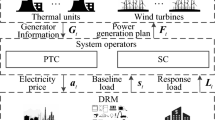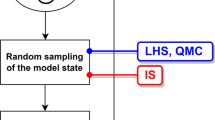Abstract
This paper seeks to solve the long-term transmission expansion planning problem in power systems more effectively by reducing the solution search space and the computational effort. The proposed methodology finds and adds cutting planes based on structural insights about bus angle differences along paths. Two lemmas and a theorem are proposed which formally establish the validity of these cutting planes onto the underlying mathematical formulations. These path-based bus angle difference constraints, which tighten the relaxed feasible region, are used in combination with branch-and-bound to find lower bounds on the optimal investment of the transmission expansion planning problem. This work also creates an algorithm that automates the process of finding and applying the most effective valid inequalities, resulting in significantly reduced testing and computational time. The algorithm is implemented in Python, using Gurobi to add constraints and solve the exact DCOPF-based transmission expansion problem. This paper uses two different-sized systems to illustrate the effectiveness of the proposed framework: the GOC 500-bus system and a modified Polish 2383-bus system.



Similar content being viewed by others
Abbreviations
- \(n\in B\) :
-
Buses (i.e., nodes)
- \((i,j)\in \varOmega \) :
-
Corridors (i.e., arcs)
- \(c_{ij,k}\) :
-
Cost of line k in corridor (i, j)
- \(c_n\) :
-
Per unit cost of generation at bus n
- \(\omega ^{0}_{ij}\) :
-
Number of established lines in corridor (i, j)
- \(\overline{\omega }_{ij}\) :
-
Maximum number of expansion lines in corridor (i, j)
- \(\overline{g}_{n}\) :
-
Maximum limit of power generation at bus n
- \({d}_{n}\) :
-
Active power demand at bus n
- \(\overline{\theta }_{ij}\) :
-
Maximum bus angle difference magnitude
- \(\overline{P}_{ij,k}\) :
-
Capacity of candidate line k in corridor (i, j)
- \(\overline{P}^0_{ij,k}\) :
-
Capacity of existing line k in corridor (i, j)
- \(x_{ij,k}\) :
-
Reactance of line k in corridor (i, j)
- \(b_{ij,k}\) :
-
Susceptance of line k in corridor (i, j)
- \(M_{ij}\) :
-
Large number (big-M) used in the disjunctive constraints
- \(\sigma \) :
-
Scaling factor to align generation and expansion costs
- \(P_{ij,k}^{0}\) :
-
Active power flow in existing line k in corridor (i, j)
- \(P_{ij,k}\) :
-
Active power flow in candidate line k in corridor (i, j)
- \(g_{n}\) :
-
Active power output of generator at bus n
- \(\theta _{n}\) :
-
Voltage angle at bus n
- \(y_{ij,k}\) :
-
Decision to construct the kth candidate line in corridor (i, j)
References
Bahiense, L., Oliveira, G. C., Pereira, M., & Granville, S. (2001). A mixed integer disjunctive model for transmission network expansion. IEEE Transactions on Power Systems, 16, 560–565.
Binato, S., Pereira, M. V. F., & Granville, S. (2001). A new Benders decomposition approach to solve power transmission network design problems. IEEE Transactions on Power Systems, 16, 235–240. https://doi.org/10.1109/59.918292.
Birchfield, A. B., Ti, X., Gegner, K. M., Shetye, K. S., & Overbye, T. J. (2016). Grid structural characteristics as validation criteria for synthetic networks. IEEE Transactions on Power Systems, 32, 3258–3265.
Cabrera, N. G., Alcaraz, G. G., & Gil, E. (2018). Transmission expansion planning considering an hourly demand curve. IEEE Latin America Transactions, 16, 869–875.
Choi, J., Timothy, M., & Robert, T. (2006). Transmission system expansion plans in view point of deterministic, probabilistic and security reliability criteria. In Proceedings of the 39th Annual Hawaii International Conference on System Sciences (HICSS’06) (Vol. 10, pp. 247b–247b). IEEE.
Conforti, M., Gérard, C., & Giacomo, Z. (2014). Integer Programming (Vol. 271). Springer.
Da Silva, E. L., Edson Luiz, J. M., Ortiz, A., Oliveira, G. C. D., & Binato, S. (2001). Transmission network expansion planning under a Tabu search approach. IEEE Transactions on Power Systems, 16, 62–68.
de Oliveira, E. J., Da Silva, I. C., Pereira, J. L. R., & Carneiro, S. (2005). Transmission system expansion planning using a sigmoid function to handle integer investment variables. IEEE Transactions on Power Systems, 20, 1616–1621.
Di, J., Tianying, C., & Yangjun, H. (2013). Review of transmission network planning in market environment. In Power and Energy Engineering Conference (APPEEC), 2013 IEEE PES Asia-Pacific (pp. 1–5). IEEE.
Dominguez, A. (2017). Planeamiento multietapa a largo plazo de redes de transmisión considerando alternativas hvdc, pérdidas y contingencias. Ph.D. thesis, Universidad Tecnologica de Pereira, Pereira.
Escobar, L. M., Escobedo, A. R., Escobar, D., & Romero, R. (2018). Bus-angle difference structural cuts for transmission system expansion planning with L-1 reliability. In 2018 EPEC. Toronto, Canada (pp. 1–6).
Escobar, L. M., & Romero, R. (2017). Angular cuts applied to the long term transmission expansion planning problem. In XLIX Simposio Brasileiro de Pesquisa Operacional (pp. 1–6).
Gallego, R. A., Monticelli, A., & Romero, R. (1998). Transmision system expansion planning by an extended genetic algorithm. IEE Proceedings-Generation, Transmission and Distribution, 145, 329–335.
García-Martínez, S., Espinosa-Juarez, E., & Jesus Rico-Melgoza, J. (2015). Expansion of electrical networks considering power quality aspects by applying a multi-objective Tabu search technique. In 2015 International Conference on Computational Science and Computational Intelligence (CSCI) (pp. 53–58). IEEE.
Garver, L. L. (1970). Transmission network estimation using linear programming. IEEE Transactions on Power Apparatus and Systems, 1688–1697.
Haffner, S., Monticelli, A., Garcia, A., Mantovani, J., & Romero, R. (2001). Branch and bound algorithm for transmission system expansion planning using a transportation model. IEE Proceedings-Generation, Transmission and Distribution, 148, 165–171. https://doi.org/10.1049/ipgtd.
Haghighat, H., & Zeng, B. (2018). Bilevel conic transmission expansion planning. IEEE Transactions on Power Systems, 33, 4640–4642.
Jenabi, M., Fatemi Ghomi, S. M. T., Torabi, S. A., & Hosseinian, S. H. (2015). Acceleration strategies of benders decomposition for the security constraints power system expansion planning. Annals of Operations Research, 235, 337–369.
Kavitha, T., Liebchen, C., Mehlhorn, K., Michail, D., Rizzi, R., Ueckerdt, T., & Zweig, K. A. (2009). Cycle bases in graphs characterization, algorithms, complexity, and applications. Computer Science Review, 3, 199–243.
Kocuk, B., Jeon, H., Dey, S. S., Linderoth, J., James Luedtke, X., & Sun, A. (2016). A cycle-based formulation and valid inequalities for dc power transmission problems with switching. Operations Research, 64, 922–938.
Latorre, G., Cruz, R. D., Areiza, J. M., & Villegas, A. (2003). Classification of publications and models on transmission expansion planning. IEEE Transactions on Power Systems, 18, 938–946.
Lumbreras, S., & Ramos, A. (2016). The new challenges to transmission expansion planning. survey of recent practice and literature review. Electric Power Systems Research, 134, 19–29.
Lumbreras, S., Ramos, A., & Sánchez, P. (2014). Automatic selection of candidate investments for transmission expansion planning. International Journal of Electrical Power & Energy Systems, 59, 130–140.
Mínguez, R., García-Bertrand, R., Arroyo, J. M., & Alguacil, N. (2018). On the solution of large-scale robust transmission network expansion planning under uncertain demand and generation capacity. IEEE Transactions on Power Systems, 33, 1242–1251.
O’Neill, R. P., Baldick, R., Helman, U., Rothkopf, M. H., & Stewart, W. (2005). Dispatchable transmission in RTO markets. IEEE Transactions on Power Systems, 20, 171–179.
Ploussard, Q., Olmos, L., & Ramos, A. (2017). An operational state aggregation technique for transmission expansion planning based on line benefits. IEEE Transactions on Power Systems, 32, 2744–2755.
Romero, R., & Monticelli, A. (1994). Expansion planning. IEEE Transactions on Power Systems, 9, 373–380.
Sahraei-Ardakani, M., & Hedman, K. W. (2015). A fast LP approach for enhanced utilization of variable impedance based FACTS devices. IEEE Transactions on Power Systems, 31, 2204–2213.
Skolfield, J. K., & Escobedo, A. R. (2021). Operations research in optimal power flow: A guide to recent and emerging methodologies and applications. European Journal of Operational Research.
Skolfield, J. K., Ramirez-Vergara, J., & Escobedo, A. R. (2021). Transmission and capacity expansion planning against rising temperatures: A case study in Arizona. In IISE Annual Conference.
Sousa, A. S., & Asada, E. N. (2011). A heuristic method based on the branch and cut algorithm to the transmission system expansion planning problem. In Power and Energy Society General Meeting, 2011 IEEE (pp. 1–6). IEEE.
Vinasco, G., Rider, M. J., & Romero, R. (2011). A strategy to solve the multistage transmission expansion planning problem. IEEE Transactions on Power Systems, 26, 2574–2576.
Wickramarathna, M. T. A. P., & Wickramaarachchi, N. (2006). Transmission network planning using genetic algorithm. In Transmission & Distribution Conference and Exposition: Latin America, 2006. TDC’06. IEEE/PES (pp. 1–5). IEEE.
Wolsey, L. A., & Nemhauser, G. L. (2014). Integer and Combinatorial Optimization. John Wiley & Sons.
Zhang, H. (2013). Transmission expansion planning for large power systems. Ph.D. thesis, Arizona State University, Tempe.
Acknowledgements
Laura M. Escobar’s work is supported by the Brazilian institutions CAPES, CNPq (Grant NO. 142150/2015-0) and São Paulo Research Foundation–FAPESP (Grant NO. 2015/21972-6). The authors acknowledge Research Computing at Arizona State University for providing HPC resources that have contributed to the research results reported within this paper. URL: http://www.researchcomputing.asu.edu.
Author information
Authors and Affiliations
Corresponding author
Additional information
Publisher's Note
Springer Nature remains neutral with regard to jurisdictional claims in published maps and institutional affiliations.
Appendix
Appendix
In order to generalize Theorem 1, we introduce new definitions. Given a path \(\rho _k\), a line path \(\ell _k\) is a sequence of exactly one line per corridor \((i,j) \in \rho _k\). The \(k^{th}\) line in corridor (i, j) will be denoted (i, j, k) for the purposes of a line path. For example, in a network with 3 lines per corridor, the simple path \(\rho =(1,2), (2,3)\) might have line paths \(\ell _1 = (1,2,1), (2,3,3)\), \(\ell _2 = (1,2,3), (2,3,3)\), or \(\ell _3 = (1,2,2), (2,3,2)\). That is, \(\ell _1\) is comprised of the first line from corridor (1, 2) and the third line from corridor (2, 3). In this basic case, there are 9 possible such line paths corresponding to the path \(\rho \). Additionally, an established line path is a line path composed entirely of existing lines, hence it corresponds to a path composed of only established paths. Let \(\mathcal {C}_\ell \) be the set of all line paths. Let \(N_{e}(\ell _k)\) denote the number of candidate lines in the line path \(\ell _k\), when \(N_e\) is applied as a function to a line path instead of a path. Let \(\mathbb {I}_{ijk}\) represent the indicator function for candidate lines (i.e., \(\mathbb {I}_{ijk} = 1\) means that line (i, j, k) is a candidate line). Given the above definitions and notations, Theorem 2 follows immediately from Theorem 1.
Theorem 2
The following are valid inequalities for TEP, for all line paths \(\ell _k \in \mathcal {C}_\ell \):
Furthermore, let \(\mathcal {C}^0 \subseteq \mathcal {C}\) denote the set of paths comprised solely of established corridors, with \(\ell _k^0\) denoting an element of this set. Additionally, let \(\underline{CR(\ell ^0)} = \min \{ CR(\ell _k^0) \}\). If \(\mathcal {C}^0\) is nonempty, then the above inequalities can be strengthened as follows:
Rights and permissions
About this article
Cite this article
Skolfield, J.K., Escobar, L.M. & Escobedo, A.R. Derivation and generation of path-based valid inequalities for transmission expansion planning. Ann Oper Res 312, 1031–1049 (2022). https://doi.org/10.1007/s10479-022-04643-1
Accepted:
Published:
Issue Date:
DOI: https://doi.org/10.1007/s10479-022-04643-1




